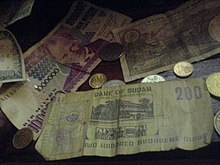The Kwacha is the currency of Zambia. It is subdivided into 100 Ngwee.

The new Israeli shekel, also known as simply the Israeli shekel, is the currency of Israel and is also used as a legal tender in the Palestinian territories of the West Bank and the Gaza Strip. The new shekel is divided into 100 agorot. The new shekel has been in use since 1 January 1986, when it replaced the hyperinflated old shekel at a ratio of 1000:1.
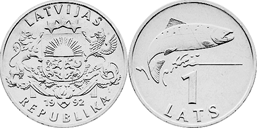
The Latvian lats was the currency of Latvia from 1922 until 1940 and from 1993 until it was replaced by the euro on 1 January 2014. A two-week transition period during which the lats was in circulation alongside the euro ended on 14 January 2014. The lats is abbreviated as Ls and was subdivided into 100 santīmi, abbreviated as an s after the santīm amount.

The Iraqi dinar is the currency of Iraq. The Iraqi dinar is issued by the Central Bank of Iraq (CBI). On 7 February 2023, the exchange rate with the US Dollar was US$1 = 1300 dinars.

The dinar is the official currency of Libya. The dinar is divided into 1,000 dirhams (درهم). It is issued by the Central Bank of Libya, which also supervises the banking system and regulates credit.

The Jordanian dinar has been the currency of Jordan since 1950. The dinar is divided into 100 qirsh or 1000 fulus. Fils are effectively obsolete; however, monetary amounts are still written to three decimal places representing fils. It is pegged to the US dollar.
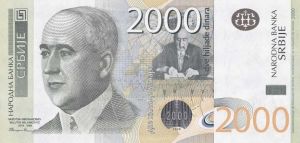
The dinar is the currency of Serbia. The dinar was first used in Serbia in medieval times, its earliest use dating back to 1214. The dinar was reintroduced as the official Serbian currency by Prince Mihailo in the 1868. One dinar was formerly subdivided into 100 para. As of 24 August 2024, 1 US dollar is worth 104.57 dinars.

The lira or pound was the currency of Malta from 1972 until 31 December 2007. One lira was divided into 100 cents, each of 10 mils. After 1986 the lira was abbreviated as Lm, although the original £M sign continued to be used unofficially. In English the currency was still frequently called the pound even after its official English language name was changed to lira.

The pound or lira was the currency of the State of Israel from 9 June 1952 until 23 February 1980. The Israeli pound replaced the Palestine pound and was initially pegged at par to £1 sterling. It was replaced by the shekel on 24 February 1980, at the rate of IS 1 = IL 10, which was in turn replaced by the new shekel in 1985.
The pound is the currency of Guernsey. Since 1921, Guernsey has been in currency union with the United Kingdom and the Guernsey pound is not a separate currency but is a local issue of sterling banknotes and coins, in a similar way to the banknotes issued in Scotland, England and Northern Ireland. It can be exchanged at par with other sterling coinage and notes.

The Egyptian pound is the official currency of Egypt. It is divided into 100 piastres, or qirsh and was historically divided into 1,000 milliemes.

The dinar is the currency of Bahrain. It is divided into 1000 fils. The Bahraini dinar is abbreviated د.ب (Arabic) or BD (Latin). It is usually represented with three decimal places denoting the fils.

The dinar is the national currency of Tunisia. It is subdivided into 1000 milim or millimes (ملّيم). The abbreviation DT is often used in Tunisia, although writing "dinar" after the amount is also acceptable ; the abbreviation TD is also mentioned in a few places, but is less frequently used, given the common use of the French language in Tunisia, and the French derivation of DT.

The Omani rial is the currency of Oman. It is divided into 1000 baisa.

The East African shilling was the sterling unit of account in British-controlled areas of East Africa from 1921 until 1969. It was issued by the East African Currency Board. It is also the proposed name for a common currency that the East African Community plans to introduce.
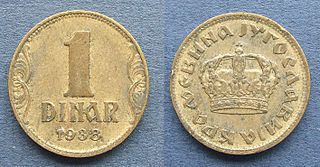
The dinar was the currency of Yugoslavia. It was introduced in 1920 in the Kingdom of Serbs, Croats and Slovenes, which was replaced by the Kingdom of Yugoslavia, and then the Socialist Federal Republic of Yugoslavia. The dinar was subdivided into 100 para.
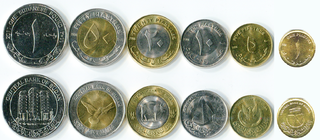
The Sudanese pound is the currency of the Republic of the Sudan. The pound is divided into 100 piastres. It is issued by the Central Bank of Sudan.

The dinar was the currency of South Arabia, and then South Yemen, and the Republic of Yemen after Yemen's monetary unification on 1 July 1990. It was one of the two official currencies used in Yemen until 11 June 1996. It was subdivided into 1000 fils (فلس).

The Palestine pound was the currency of the British Mandate of Palestine from 1 November 1927 to 14 May 1948, and of the State of Israel between 15 May 1948 and 23 June 1952, when it was replaced with the Israeli pound.

The South Sudanese pound is the currency of the Republic of South Sudan. It is subdivided into 100 piasters. It was approved by the Southern Sudan Legislative Assembly before secession on 9 July 2011 from Sudan.

